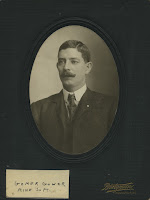Double Take: Re-Opening the Thurber Mines
By Lea Hart
Historical
interviews serve as a window into a past most of us will most likely never be
able to fathom. Thurber interviews detail smaller bits of history not everyone
thinks of: daily life. Some detail their favorite teacher with her long black
skirt, white shirt with lace down the front, and hair in a bun on the top of
her head (apparently a popular hair style in Thurber); others of the boy down
the street who they would fight with about climbing a tree before later becoming
best friends. A few interviews offer clues that lead historians on a hunt for
buried history. On June 10, 2000, interviewer Curtis Tunnel sat down with a
former Thurber resident Billy Gene McGinnis, during which McGinnis shared a
tantalizing bit of information about the short- term reopening of the mines
after Thurber closed.
 |
| After the mines closed, steel, copper, and miners tools were left behind, useful for later salvaging efforts. Mine Number 1 Courtesy: Miles Hart Collection, Haley Library |
Mr. McGinnis recalled that during
his high school years, around World War II, a company re-opened the mines to salvage
copper wire and steel left when the mines closed in 1920s. McGinnis added that only one or two of the
mines were opened and that this was done for military purposes. This retrieval
process only went on for one or two years as a few people died due to the black
damp (a mixture of carbon monoxide, carbon
dioxide, nitrogen and other gasses) which suffocates those who inhale it. This
was one of the first times some of the Gordon Center staff had heard of the reopening
of the mines, sparking our interest.
An
article from The Dublin Progress, of Dublin, Texas, published on January
14, 1938, sheds some light on this matter. The article, written prior to World
War II, tells us that the Ab-Tex Equipment Company went into a few of the mines
in order to salvage the mass amount of equipment, copper wire and other miscellaneous
materials and tools left onsite when the miners left for the last time in 1923.
The article lists Gomer Gower as head of the operation, as well as seven other
former Thurber miners. After the mention of Gomer Gower we were able to piece
just a bit more of this puzzle together with our own collections.
 |
| Gomer Gower, a former Texas and Pacific Coal Company employee later worked for Ab-Tex to salvage materials from the mines. Courtesy: Miles Hart Collection, Haley Library |
In
a letter to Mary Jane Gentry, Mr. Gower writes that Ab-Tex employed him from
November 25 to December 31, 1937, to salvage the material left inside the mines
by the Texas Pacific Coal Company; specifically in mines number 1, 3, and 10. Gower’s
differences in opinion with Ab-Tex safety policies cut short his time with the
company. Shortly after three deaths involving the black damp Ab-Tex packed up.
He also writes that later the government took over and placed the job in the
hands of the Federal Bureau of Mines.
If
this is the case then not only was Mr. McGinnis correct about the opening of
the mines during WWII to help with the war effort, but also that the mines were
opened during the Great Depression to help provide more tools to other miners, across
the nation, when needing mining materials were at an all-time low. All this
means that this long dead coal mining town was brought back to life, not once,
but twice, if only for a short time.

